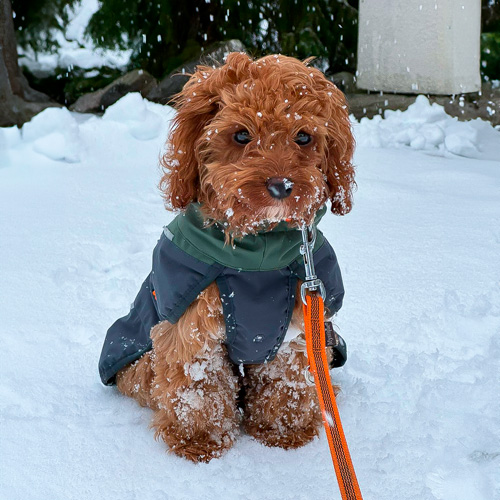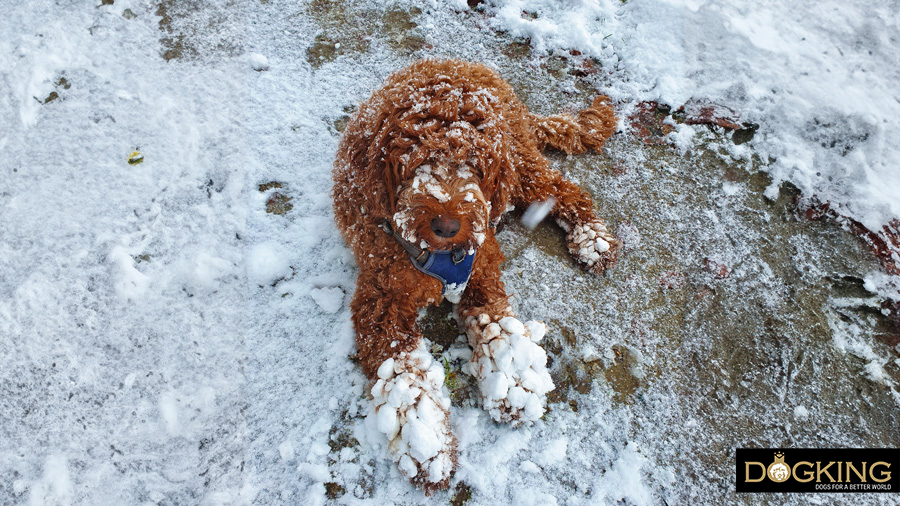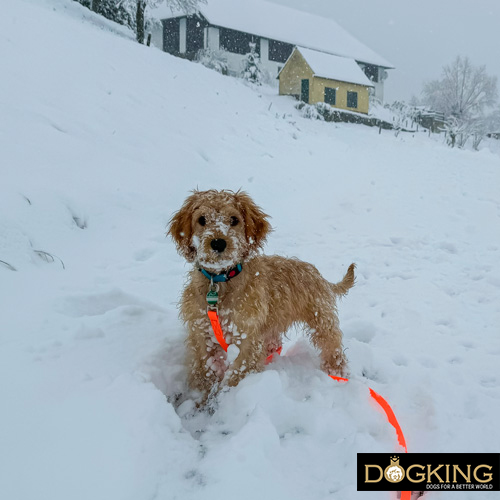Frieren Hunde im Winter?
Obwohl ihr Fell sie schützt, kann es ihnen bei kaltem Wetter trotzdem schwer fallen

DER NATÜRLICHE KÄLTESCHUTZ DES HUNDES
Ungefähre Lesezeit : 5 minuten
Wenn es kalt wird, holen wir schnell die Winterjacken raus, drehen die Heizung auf und füttern uns mit warmen und herzhaften Rezepten. Aber was passiert mit unseren pelzigen Freunden? Wie schützen sich unsere pelzigen Freunde vor dem Temperatursturz? Hunde können sich mit ihrem Fell gegen die Kälte isolieren. Im Herbst findet bei vielen Hunderassen einer der beiden jährlichen Haarwechsel statt, um sie auf den Winter und den Rückgang des Thermometers vorzubereiten. Hinzu kommt auch noch, dass viele Rassen dieser Hunde über eine Lipid- oder Fettschicht verfügen, die als natürliche Barriere gegen Kälte wirkt. Jedoch ist das ausreichend, um sich von den Folgen der kalten Temperaturen zu schützen? Stimmt es, dass Hunde im Winter frieren?

Inhaltsverzeichnis
Auch Hunde fühlen Kälte
Bei welcher Temperatur friert ein Hund?

Genau wie bei den Menschen ist es bei manchen Hunden kälter als bei anderen. Das hängt von der Größe und der Art des Fells ab, kann aber auch innerhalb einer Rasse von Tier zu Tier variieren, da jeder Pelzhund anders ist. Im Allgemeinen sprechen wir von einem Hund, der unter 4°C oder bei hoher Luftfeuchtigkeit sogar unter 8 °C zu frieren beginnt. Jenseits dieser Temperatur und bis hinunter zu 0 °C kann die Kälteempfindlichkeit unterschiedlich ausgeprägt sein, wobei die Situation zwischen 3 °C und 0 °C für einige Hunde gefährlich werden kann. Bedenken Sie, dass Hunde zwar von Natur aus besser gegen Kälte geschützt sind als wir, aber auch eine höhere Körpertemperatur haben, etwa 38-39 °C, so dass sie schneller frieren können, als wir denken.
Welche Hunde frieren am ehesten?
Die Empfindlichkeit der Hunde kann je nach Größe variieren. Kleine Hunde wie Chihuahuas, Dackel und Pomeranians haben einen schnellen Stoffwechsel, durch den die Wärme leichter entweichen kann, was sie besonders empfindlich gegenüber kalten Temperaturen macht. Außerdem müssen sie im Verhältnis zu ihrem Gewicht mehr Körperoberfläche an die Luft abgeben müssen, können sie die Wärme nicht so gut speichern wie Hunde großer Rassen. Die großen Hunde haben dagegen einen langsameren Stoffwechsel, der die Körpertemperatur viel besser reguliert.

Die Größe ist jedoch nicht der einzige Faktor, der das Kälteempfinden eines Hundes beeinflusst. Wenn Ihr Haustier ein kurzes Fell hat, selbst wenn es groß ist wie ein Windhund oder ein Boxer, kommt es möglicherweise nicht so gut mit kalten Temperaturen zurecht, da sein dünnes Fell es nicht so gut vor der Umwelt schützt. Langhaarige Hunde, wie der Australian Cobberdog, sind dagegen durch ihr dichtes Fell besser gegen Kälte isoliert. Nicht zu vergessen sind die Schlittenhunderassen wie der Alaskan Malamute oder der Siberian Husky, die aufgrund ihrer Herkunft und Evolution sehr viel kältetoleranter sind, auch bei Temperaturen unter dem Gefrierpunkt.
Anzeichen dafür, dass Ihr Hund kalt ist

Das erste Anzeichen dafür ist, dass die Umgebung für Ihren pelzigen Freund zu kalt ist, die Temperatur seiner Ohren und seines Körpers im Allgemeinen. Hunde sind normalerweise wärmer als wir, wenn man sie berührt, da ihre natürliche Körpertemperatur höher ist als unsere. Wenn Sie Ihren Hund streicheln und er sich kalt anfühlt, ist es gut möglich, dass es ihm schlecht geht. Andere Anzeichen dafür, dass Ihr Hund friert, sind Zittern, Steifheit, Wimmern, Kurzatmigkeit, gesträubtes Fell oder übermäßige Schläfrigkeit. Außerdem wenn Sie zu Hause bemerken, dass er immer an die Heizung geht, stundenlang zusammengerollt schläft und nicht mehr so gerne nach draußen geht wie früher, ist es sehr wahrscheinlich, dass es ihm kalt ist.
Wie Sie Ihren pelzigen Freund vor kalten Temperaturen schützen können

Wenn Sie einen kleinen Hund haben, mit kurzen Haaren oder einfach fröstelnden Hund, sollten Sie ihn nicht den eisigen Temperaturen aussetzen. Vermeiden Sie Spaziergänge früh am Morgen und am Abend, wenn das Thermometer sinkt und es meist feuchter ist. An kalten Tagen in hochwertige, atmungsaktive und wasserdichte Kleidung ein, wenn es regnet, aber denken Sie daran, sie auszuziehen, wenn Sie nach Hause kommen oder wenn Sie Sport treiben. Das ist besonders wichtig für Welpen, sehr alte Hunde oder Hunde, die an einer Krankheit leiden.
Sorgen Sie zu Hause für eine angenehme und stabile Temperatur, auch wenn Sie nicht zu Hause sind. Bieten Sie Ihrem Hund einen warmen, bequemen Schlafplatz, z. B. ein beheiztes Bett (Sie können aber auch ein normales Bett verwenden und eine Decke darüber legen).